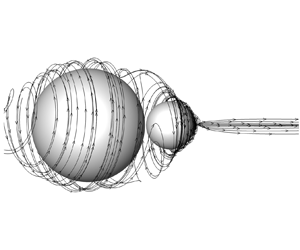Article contents
A freely suspended robotic swimmer propelled by viscoelastic normal stresses
Published online by Cambridge University Press: 28 June 2022
Abstract

We present a self-propelled axisymmetric low-Reynolds-number swimmer (force- and torque-free) that, while unable to swim in a Newtonian fluid, propels itself in a non-Newtonian fluid as a result of fluid elasticity. The propulsion gait is pure ‘swirling’ and is demonstrated using a robotic swimmer, comprised of a ‘head’ sphere and a ‘tail’ sphere, whose swimming speed is shown to demonstrate good agreement with a microhydrodynamic asymptotic theory and numerical simulations. Schlieren imaging demonstrates that propulsion of the swimmer is driven by a strong viscoelastic jet at the tail, which develops due to the fore–aft asymmetry of the swimmer. Optimized cylindrical and conic tail geometries are shown to double the propulsive signal, relative to the optimal spherical tail. We show that we can use observations of this robot to infer rheological properties of the surrounding fluid. We measure the primary normal stress coefficient  $\varPsi _1$ at shear rates
$\varPsi _1$ at shear rates  ${<}1\,{\rm Hz}$, and show reasonable agreement with extrapolated bench-top measurements (
${<}1\,{\rm Hz}$, and show reasonable agreement with extrapolated bench-top measurements ( $0.8\unicode{x2013}1.2\,{\rm Pa}\,{\rm s}^2$ difference). We also derive how the head rotation may be used to measure the second normal stress coefficient,
$0.8\unicode{x2013}1.2\,{\rm Pa}\,{\rm s}^2$ difference). We also derive how the head rotation may be used to measure the second normal stress coefficient,  $\varPsi _2$. The study demonstrates the exciting potential for a ‘swimming rheometer’, examining the intersection between swimming and sensing in complex fluids.
$\varPsi _2$. The study demonstrates the exciting potential for a ‘swimming rheometer’, examining the intersection between swimming and sensing in complex fluids.
- Type
- JFM Papers
- Information
- Copyright
- © The Author(s), 2022. Published by Cambridge University Press
References
REFERENCES
Kroo et al. supplementary movie 1
Schlieren imaging of a propelling swirler, demonstrating a non-inertial, viscoelastic jet coming off the tail (to the left). The counter-rotating head is on the right, and the robot propels to the right. 8x playback speed.
- 8
- Cited by





